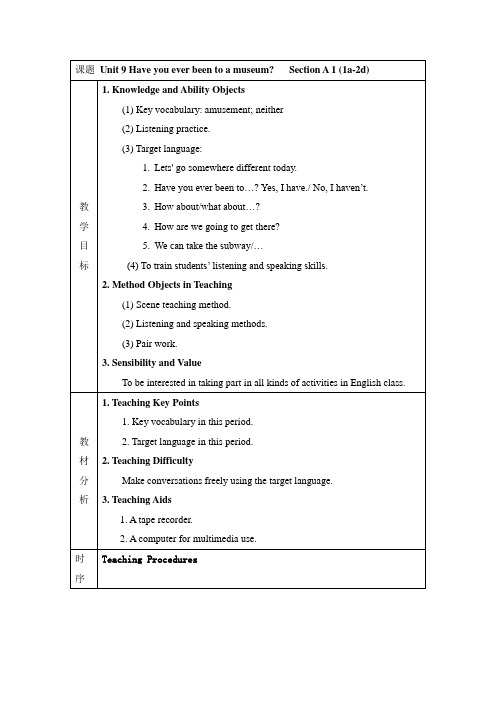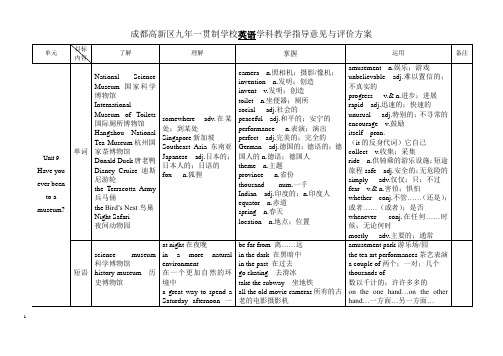2014年新目标人教版八年级英语下册Unit9 Have you ever been to a museum SectionA 课件
- 格式:ppt
- 大小:1.80 MB
- 文档页数:39




Unit 9 Have you ever been to a museum?Section ALanguage Goal: Talk about past experiences[iksˈpiəriənsiz]Have you ever been to a science museum?Yes, I have. I went to the national Science Museum Last year. Have you ever been to a history museum?No, I haven’t.Me neither. Let’s go to one tomorrow.Me neither. 常用于口语中,相当于Neither have I.或I haven’t ,either.表示前面所表达的否定情况也同样适合于他人或他物。
Me neither.与Me too.相对。
Me too.表肯定,Me neither.表否定。
-Lucy can't play the guitar. 露西不会弹吉他。
-Me neither.我也不会。
辨析: one, that与it①.one意为“一个人或物”,代替前面提到过的人或同类事物中的一个。
one代替可数名词,复数形式为ones. -That boy is my brother.那个男孩是我的弟弟。
-Which one? 哪一个?-The one on a bike. 骑自行车的那个。
②.that与所指名词同类,但不是同一个;可代替上文提到的事情,也可代替不可数名词。
The population of China is much larger than that of America. 中国的人口比美国的人口多得多。
③it用于指代前面提到过的名词,即同名同物。
-Do you like the game? 你喜欢这个游戏吗?-Yes, I like it. 是的,我喜欢。

Unit 9 Have you ever been to a museum?Level: 8th gradeObjectives:To introduce and practice vocabulary related to museums and exhibitions.To develop listening and speaking skills through a discussion of different types of museums.To practice writing skills by creating a brochure for a museum.Materials:Handout with vocabulary related to museums and exhibitions.Pictures of different types of museums.Audio recording or video of a museum tour.Worksheets with comprehension questions about the museum tour.Blank brochures or paper for students to create their own museum brochures.Procedure:Introduction:Greet the class and review any previous lessons on cultural institutions, such as art galleries or libraries.Introduce the topic of the lesson, which is museums.Ask the class if they have ever been to a museum or if they are familiar with the different types of museums.Vocabulary:Distribute the handout with vocabulary related to museums and exhibitions.Review the vocabulary with the class, using examples and visual aids as necessary.Have students practice using the vocabulary in context, such as by describing their favorite museum or exhibition.Listening and Speaking:Show pictures of different types of museums, such as art museums, history museums, and science museums.Have students discuss in pairs or small groups which types of museums they have been to and what they enjoyed about those museums.Play an audio recording or video of a museum tour, such as a guided tour of an art museum or a virtual tour of a historical site.Pause periodically to ask comprehension questions about the tour, such as the names of different exhibits or the historical significance of a particular artifact.Writing:Explain to the class that they will be creating their own museum brochures.Provide blank brochures or paper for students to create their brochures.Have students choose a type of museum and create a brochure that includes information about the museum's exhibits, history, and location.Encourage students to use descriptive language and visuals to make their brochures engaging and informative.Conclusion:Summarize the main points of the lesson, emphasizing the vocabulary and listening, speaking, and writing skills that were practiced.Encourage students to continue exploring different types of museums and exhibitions.Assign homework, such as visiting a museum and writing a reflection about their experience.Assessment:Throughout the lesson, assess students' understanding of the vocabulary and listening comprehension by observing their participation in discussions and their completion of worksheets.Evaluate students' writing skills by reviewing their museum brochures and providing feedback on their use of descriptive language and visuals.Use a rubric to grade students' homework assignments, such as their museum reflections or research on a particular type of museum.Extension:Plan a class field trip to a local museum or exhibition.Have students create a presentation about a particular exhibit or artifact in a museum.Invite a guest speaker, such as a museum curator or historian, to talk to the class about the importance of museums in preserving and sharing cultural heritage.Possible homework assignments for this lesson include:Visit a museum and write a reflection about your experience. Include details about the exhibits you saw, what you learned, and how the experience impacted you.Research a particular type of museum, such as an art museum or science museum, and create a presentation about the history and significance of that type of museum.Choose a famous museum and write a short report about its history, notable exhibits, and impact on society.Create a virtual museum tour using technology such as PowerPoint or Prezi. Choose a theme, such as "Women's History" or "Ancient Civilizations," and include images and information about different exhibits.Design a museum exhibit on a particular topic, such as the environment or human rights. Create a plan for the exhibit, including the layout, artifacts, and interactive elements.Interview a museum curator or historian and write an article about their work and the importance of museums in preserving and sharing cultural heritage.Create a museum brochure for a fictional museum. Choose a theme, such as "Mythical Creatures" or "Future Technology," and include information about the exhibits, history, and location.Write a persuasive essay about the importance of museums in society. Argue why museums are valuable resources for education, cultural preservation, and community engagement.。

Have/has been to与have/has gone to教学目标:学生通过观察不同情境中have/has been to与have/has gone to的使用,归纳总结现在完成时中have/has been to与have/has gone to的用法,并能在现在完成时中恰当使用。
教学重难点:掌握have/has been to与have/has gone to的区别,并能在现在完成时中恰当使用。
教学步骤:Step 1 Lead inPresent two different situations in which have/has been to and have/has gone to, to show the meanings and the differences between have/has been to and have/has gone to in The present perfect tense.Step 2 PresentationShow some sentences and have students summarize the difference between have/has been to and have/has gone to, and tell the students to recall the main usages of have/has been to and have/has gone to.have/has been to and have/has gone to它们都表示去某个地方,都是现在完成时态,表明动作已经发生,但是他们的含义是不同的。
have/has been to 表示某人曾去过某地(现在已经回来)。
如:He has been to American twice.他去过美国两次了I have ever been to the Great Wall.我曾经去过长城。
Unit 9 part B 教案【教学目标】(1) Target language.Have you ever tried/seen/been…?If you…, you will/can…You should…One great thing about …is…(2)To train students speaking and writing abilities.【教学重点】get information from the textlearn new words and expressions【教学难点】Improve students’ writing abilityarise discussion and guide students to ask questions and find answers on their own 【教学方法】PWP method, task-based method and interactive approach【教学手段】A tape recorder, multimedia and some pictures【教学过程】Teaching Procedures:Step 1 RevisionWhat do you know about Singapore?position: Where is Singapore?position: in Southeast AsiaPopulationMore than three quarters of the population are Chinese.LanguageChinese and English.FoodA lot of food from China, such as rice, noodles and dumplings.Indian food, western food and Japanese food.ZooSingapore has a special zoo called the “Night Safari”. A lot of animal only wake up at night, so this is the best time to watch them.WeatherThe temperature is almost the same all year round.Step 2 Writing3b Write an article to advertise your hometown or a place you have been to.句型:Have you ever tried/seen/been…?If you…, you will/can…You should…One great thing about …is…Step 3 Self checkThink about the things below and write an answer for each one.1) One thing that you have collected before:_________________________________2) One invention that you have found to be very useful:_________________________________3) One unbelievable or unusual thing that you’ve seen or heard recently:_________________________________4) One way that you’ve used to encourage a friend in the past:Step 4 HomeworkWriting写作要求:写一篇80字的文章描述你的家乡或者你去过的地方。
Unit 9 (8B) Have you ever been to anamusement park?I. Teaching aims1.Help the students master the words and expressions.2.Help the students learn to talk about the places they havebeen to.3.Realize the beautiful life and enjoy it.II. Key points and difficulties1.The patterns of “ have/has been to”.2.Talking about the places they have been to.III. Teaching methodsListening, oral and writing practice.IV. Studying methodsPairwork and groupwork.V. Teaching procedures:Step 1 Warm up and lead inA guessing game and a short video to present “have been to”.Step 2 PairworkLearn the new words with the help of pictures. Then present thenew dialogue and have the students practice the dialogue.Step 3 1b listen and find out what places they have been to.Step 4 Game(magic eyes)Show the photos of some places quickly, have the students tell the answers quickyly. It is to practice “He/She has been to…”Step 5 2a Listening. Listen and circle the places they hear.Step 6 2b ListeningStep 7 GroupworkWork in groups of four. Take turns to ask their partners. The others answer the questions as quickly as you can.Step 8 SummaryAsk the students to summarize what we learned. (words and expressions)Step 9 Surveyone of their friends and write the report.their passages in class.Step 10 HomeworkWrite about one of their own trips by using what they have learned.Enjoy traveling!Survey one of your friends and try to write your report.1.Do you like going out on vacation ?Very much A little Not at all2.How often do you go out to have fun?Usually Often Sometimes Never 3.Where have you been?_______________________________4.When did you go to …?_______________________________5.Where are you going next vacation?_______________________________6.How are you going there?Other ways ___________7. (other questions you want to know)…Report: My good friend … likes …. She/He…。